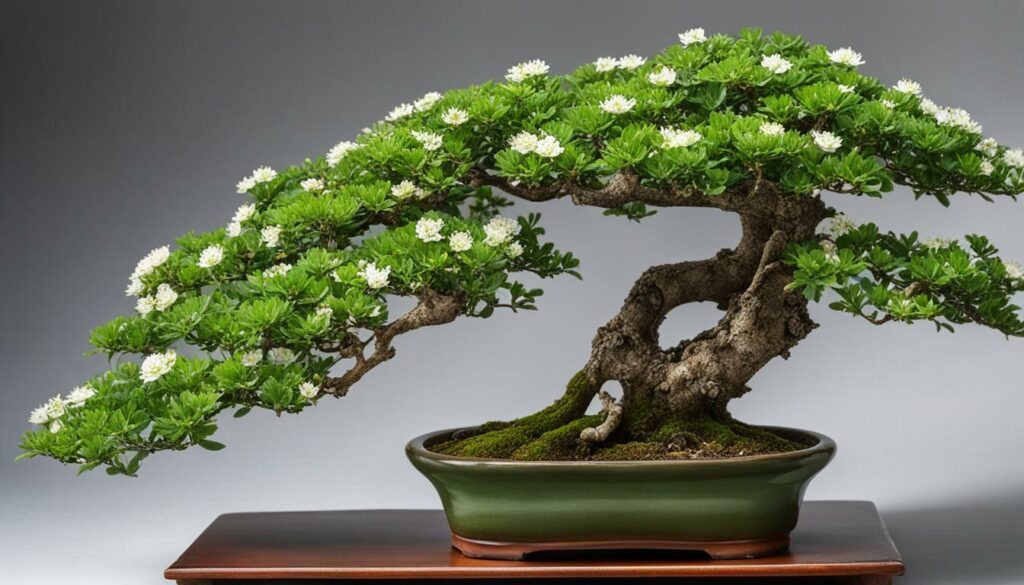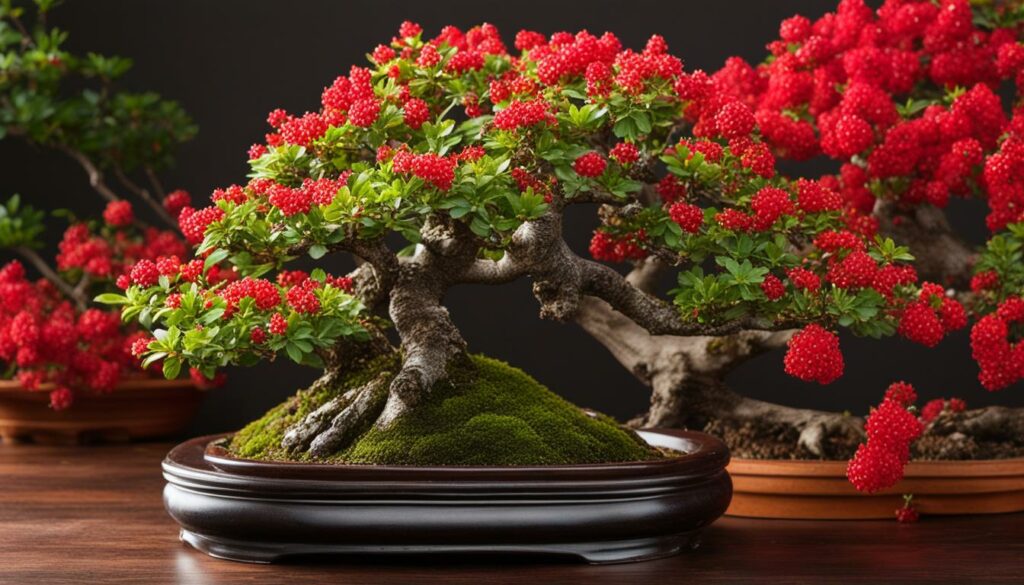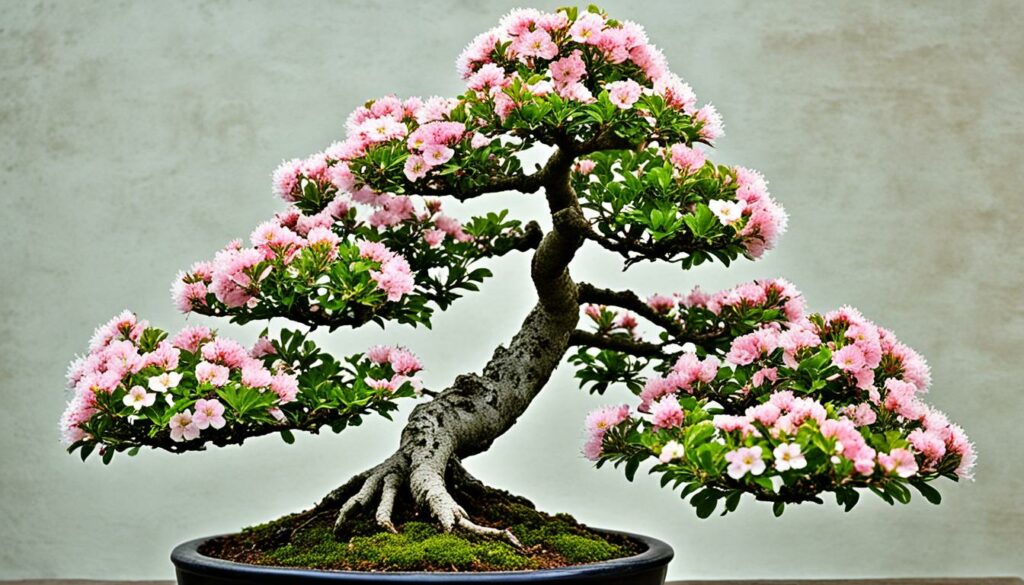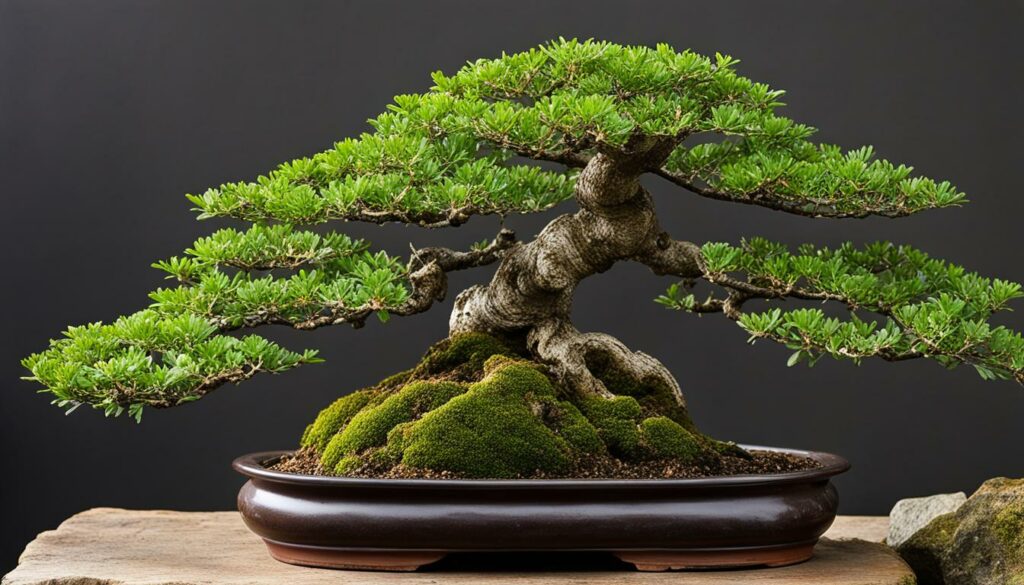If you’re looking to enhance your gardening artistry with a resilient and beautiful Bonsai tree, the Hawthorn bonsai species is an excellent choice.
The Hawthorn bonsai is also known as the Crataegus bonsai. It is a flowering bonsai that captivates with its delicate blooms and captivating foliage. In this section, we’ll delve into why the Hawthorn bonsai is a popular choice among bonsai enthusiasts, its resilience, and how to care for it.
Key Takeaways:
- The Hawthorn bonsai is a hardy and low-maintenance choice for bonsai gardeners.
- It is a flowering bonsai that adds a unique and enchanting charm to your garden.
- The Hawthorn bonsai is also known as the Crataegus bonsai.
- Its delicate flowers and captivating foliage make it a captivating species.
- The Hawthorn bonsai can tolerate different environmental conditions, making it a resilient choice.
Introduction to the Hawthorn Bonsai
If you are looking for a stunning flowering bonsai, the Bonsai Tree Species Hawthorn (Crataegus bonsai) might just be the perfect addition to your garden. This beautiful tree is native to Europe, Asia, and North America and has been a popular choice among bonsai enthusiasts for generations.
Like all bonsai, the Hawthorn bonsai is created by shaping a young tree into a miniature version of itself. The process takes patience and skill, but the resulting tree is a work of art that deserves to be admired.
The Hawthorn bonsai has a tough exterior, which makes it an excellent choice for beginners. Its hardy nature means it can tolerate a variety of environmental conditions, making it more resilient than many other flowering bonsai species.
In the following sections, we will explore the characteristics and beauty of the Hawthorn bonsai in more detail.

Origins of the Hawthorn Bonsai
The Hawthorn bonsai originates from the Hawthorn tree, which is a deciduous shrub or small tree that is commonly found in hedgerows throughout Europe, Asia, and North America. The Hawthorn tree can grow up to 50 feet tall and live for over 100 years.
Characteristics of the Hawthorn Bonsai
The Hawthorn bonsai has striking foliage, which turns into a beautiful burgundy color in autumn. In spring, it produces delicate pink or white flowers that give off a pleasant fragrance and attract bees and other pollinators. Its small red berries are a favorite among birds.
| Common Name | Hawthorn Bonsai |
|---|---|
| Scientific Name | Crataegus bonsai |
| Family | Rosaceae |
| Size | Up to 30 cm tall |
| Flowers | White or pink |
| Fruit | Red berries |
| Hardiness | Zone 4-8 |
The size of the Hawthorn bonsai is highly variable, depending on the cultivar and care. Some Hawthorn bonsai can grow up to 30 cm tall, while others remain tiny miniatures, just a few inches in height.
Why Choose the Hawthorn Bonsai
There are many reasons to choose the Hawthorn bonsai as your next gardening project. Its resilience makes it a great option for beginners, while its delicate flowers and beautiful foliage make it a favorite among experienced bonsai enthusiasts. The Hawthorn bonsai can bring a unique charm to your garden and provide you with hours of enjoyment as you watch it grow and evolve over time.
The Resilience of the Hawthorn Bonsai
The Hawthorn bonsai is a resilient tree species that can survive in various environmental conditions, making it a perfect choice for bonsai enthusiasts. This hardy tree can grow in both warm and cold climates and can withstand drought, heat, and frost, making it low-maintenance and easy to care for.
In fact, the Hawthorn bonsai is quite adaptable. It can grow in full sun or partial shade, and can even thrive in poor soil conditions. It is also resistant to most pests and diseases, making it a worthy investment for any gardener.
One of the reasons the Hawthorn bonsai is so resilient is due to its small leaves and dense branches. These features help the tree to regulate its water consumption, reducing the risk of dehydration.

Overall, the resilience of the Hawthorn bonsai makes it an ideal choice for those who want a beautiful and easy-to-care-for bonsai tree. Whether you are a beginner or an experienced gardener, this bonsai species can be enjoyed by all levels of skill and expertise.
The Beauty of Hawthorn Bonsai
When it comes to beauty, the Hawthorn bonsai does not disappoint. This charming bonsai boasts delicate flowers that bloom in different colors, including pink, white, and red, in early summer. The foliage of the Hawthorn bonsai is also captivating, with dark green leaves that turn yellow or orange in the fall.
To ensure that your Hawthorn bonsai tree reaches its full potential, proper care is essential. The tree requires bright, indirect sunlight and moderate watering. Pruning at the right time of year is also crucial, as it encourages healthy growth and helps maintain the tree’s shape.

Adding a Hawthorn bonsai to your garden is an excellent way to bring natural beauty into your space. Whether you have other bonsai trees in your collection or are just starting, the Hawthorn bonsai is a great addition that complements any garden.
Conclusion
Now that you have explored the beauty and resilience of the Hawthorn bonsai, it’s time to add this enchanting flowering tree species to your gardening collection. Whether you are a beginner or an experienced bonsai gardener, the Hawthorn bonsai is a hardy and low-maintenance choice that thrives in different environmental conditions.
With its delicate flowers and captivating foliage, the Hawthorn bonsai is a perfect addition to your garden. Ensure that you care for it properly, and it will reward you with its full potential. Remember to water it regularly, provide it with enough light, and prune it to maintain its shape.
Whether you’re looking to enhance your gardening artistry or simply want to add a unique charm to your garden, explore the possibilities of the Hawthorn bonsai. It’s a remarkable tree species that combines resilience with beauty, and it’s waiting for you to bring it home.
FAQ
What is a Hawthorn bonsai?
A Hawthorn bonsai is a miniature version of the Hawthorn tree, scientifically known as Crataegus. It is a type of flowering bonsai that is cultivated and trained to mimic the shape and characteristics of a full-sized Hawthorn tree.
Are Hawthorn bonsai trees hardy?
Yes, Hawthorn bonsai trees are known for their resilience and hardiness. They can tolerate a wide range of environmental conditions, including cold winters and hot summers. This makes them suitable for both indoor and outdoor cultivation.
How often should I water my Hawthorn bonsai?
The watering frequency for a Hawthorn bonsai tree will depend on various factors such as the climate, soil type, and size of the tree. As a general guideline, it is recommended to water your Hawthorn bonsai thoroughly when the top inch of soil feels dry. Avoid overwatering, as it can lead to root rot.
Do Hawthorn bonsai trees flower?
Yes, Hawthorn bonsai trees produce beautiful flowers in spring. These flowers come in shades of white or pink and add a charming aesthetic to the tree. It is important to provide the necessary care, such as proper pruning and fertilization, to encourage healthy flowering.
Can I keep my Hawthorn bonsai indoors?
While Hawthorn bonsai trees can tolerate indoor conditions temporarily, they are best suited for outdoor cultivation. These trees require ample sunlight and fresh air to thrive. If you choose to keep your Hawthorn bonsai indoors, make sure to provide it with sufficient light and proper ventilation.
How do I prune my Hawthorn bonsai?
Pruning is an essential task in maintaining the shape and health of a Hawthorn bonsai. It is recommended to prune your tree during the dormant season, typically in late winter or early spring. Remove any dead, diseased, or crossing branches, and selectively trim the foliage to achieve the desired bonsai aesthetic.
How long do Hawthorn bonsai trees live?
With proper care and maintenance, Hawthorn bonsai trees can live for several decades. The lifespan of a Hawthorn bonsai will depend on factors such as its genetic traits, growing conditions, and the care it receives. Regular watering, fertilization, pruning, and protection from extreme weather conditions will contribute to its longevity.


